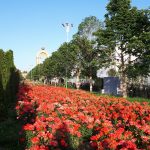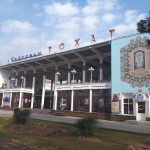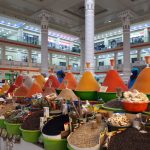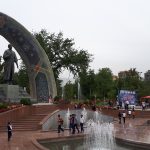Tajikistan has a rich and incredibly diverse history with its notorious Soviet past and age-old Tajik culture. You can learn about famous celebrities from Tajikistan history, uncover ancient artifacts and tools, and discover deep-rooted traditions of the Tajik ancestors with a visit to a variety of well-displayed museums in Tajikistan
From thousand-year-old settlements to centuries-old pottery, jewelry and war relics, the museums of Tajikistan do not disappoint. And we are not only talking about the museums in Dushanbe, Tajikistan. There are several fascinating museums outside of the capital that are worth exploring too.
Here are some of the best museums Tajikistan has to offer:
The Museum of Antiquities in Dushanbe
Dating back to 1934 when it had over 500 informal exhibits, the National Museum of Antiquities, Dushanbe was only officially established as a proper museum in 2001. Since then, it has morphed into Tajikistan’s most-visited museum.
As the main museum of antiquities of Tajikistan, the two-story building is spread across 22 exhibition halls spanning the periods from the 4th-millenium BC to the start of the 20th-century. They detail natural history, historical and modern history, archaeology, and fine arts. Amongst the collection of centuries-year-old artifacts, you will find everything from jewelry, coins and ceramics to ancient tools, musical instruments, and weapons.
The most notable collections in the National Museum of Antiquities, Tajikistan, include the remains of the Oxus Temple found at the Takhti-Sangin archaeological site and the 5.5-ton Sleeping Buddha of Buddha in Nirvana that was found at the Ajina-Tepa Buddhist monastery near Kurgan-Tyube, Tajikistan.
Other exhibits feature the fascinating finds from digs performed at the ancient settlements of Hulbuk Fortress and Sarazm, as well as near the modern-day cities of Khujand, Panjakent, Kurgan-Tyube, and Istaravshan. Check the museum’s website for up-to-date Tajikistan National Museum of Antiquities opening hours.
Musi Instrumental Gurminj
The Musi Instrumental Gurminj, perhaps better known as the Gurminj Museum of Musical Instruments, is located behind the mayor’s office in Dushanbe, Tajikistan. Established in 1990 by a famous Tajik musician, Gurminj Zavkibekov, who was both a National Artist of Tajikistan and a winner of the Rudaki State Prize, it is home to over 100 musical instruments.
Most of the instruments in the Gurminj museum in Dushanbe are from Zavkibekov’s private collection, and are mostly string instruments. They represent Central Asian cultures, such as the Pamiri Ismaili musical culture of Tajikistan. You can find instruments like the rubab, tanbur, tar, setor, as well as traditional drums like daf and doyra here.
Tajikistan’s Gurminj Museum of Music Instruments is an impressive complex that includes various exhibition halls, a performance venue, a musical instrument workshop, a library, and even a recording studio.
With an emphasis on making music relatable for everyone, the museum offers regular tours run by local musicians and visitors are encouraged to hold, touch and try out the musical instruments for themselves. If you are more of a listener yourself, there are cultural nights and events held at the museum where you can enjoy the sounds of traditional Pamiri music.
While entrance to the Gurminj Museum of Tajikistan is free, it is mainly run by volunteers so any donations or contributions are welcome.
Muboraki Vakhoni’s Museum
The house museum of Muboraki Vakhoni in the Wakhan Corridor of Tajikistan makes for a fascinating visit. Located in Yamgchun village, Muboraki Vakhoni’s Museum is dedicated to the life of a famous Tajik scientist and philosopher.
Sufi Muboraki Vakhoni lived in the house from birth to death and this Tajik scientist from Pamir is like Tajikistan’s very own Leonardo da Vinci. A collection of interesting inventions and musical instruments are spread across various exhibitions in the former home of Muboraki Vakhoni. Not only are the age-old works inside the house fascinating to witness but you can also get a feel for a typical Pamirian house in the typical Pamirian village of Yamchun
One of the most famous sights at the Muboraki Vakhoni Museum along the Pamir Highway is the stone astronomical calendar he invented that lies dotted around the surrounding mountains. At specific times of the year, you can view the sun and the stars through them.
Rudaki Museum in Penjikent
Tajikistan’s Rudaki Museum, also known as the Republican Museum of History and Local Lore of Rudaki, is located within a one-story building in the center of modern-day Penjikent, Tajikistan. It is a rather attractive building in itself with gorgeous white Doric columns flanking the entranceway.
Established in 1958 in honor of famous writer Abu Abdullah Rudaki, lovingly dubbed the ‘Father of Persian Poetry’ or the ‘Adam of Poets’, Penjikent’s Rudaki Museum is home to eight exhibition halls that tell the tale of the history of Tajikistan.
One of the most famous exhibits inside Penjikent’s Rudaki Museum is the fine collection of textiles, ancient costumes, and frescoes from the ancient settlement of Penjikent dating between the 5th and 7th centuries.
Another highlight is the Neolithic tools that were excavated at the Sarazm (Sarazam) settlement, a UNESCO World Heritage Site not far away. Some of the relics found there date back further than 5,000 years ago!
You cannot miss the museum’s namesake: the exhibition dedicated to Rudaki, the founder of Tajik literature. It features some of the lyricist’s best works.
Other interesting exhibits at the Rudaki Museum in Penjikent include those dedicated to the Samanid era. There is an impressive collection of pottery, gold coins, and hundreds of historical documents to be witnessed.
Historical Museum in Khujand
Officially known as the Historical Local Lore Museum of Archeology and Fortification, this regional history museum in Khujand, Tajikistan, is filled with historical relics, antiques, and artifacts detailing the history of the Sughd region and beyond.
Located within a beautiful mud-brick castle-like fortification in the center of Khujand, the Historical Museum of Sughd is worth visiting for the architecture alone. Small it may be but the museum is done well with fascinating collections of ancient pottery, WWII uniforms and medals, Persian relics, and historical portraits. Noteworthy sights include the mosaic exhibit on the life of Alexander the Great and the large statue of Khujand’s former governor, Temur Malek.
The Khujand museum gift shop is an amazing place to pick up some great souvenirs for home – past visitors have reported them better than any you can find in a Tajikistan bazaar.
The only downside to the Historical Museum in Khujand is that most of the exhibits and signs are written in the Tajik language and there are few, if any, English explanations given. For this reason, a guided tour of the Historical Museum of Sughd in Khujand is highly recommended.
You can combine a visit to any of the above museums in Tajikistan on a museum tour with Paramount Journey. Visiting all of the best museums in Tajikistan, it is one of the best ways to uncover the history of this fascinating country. Take a look at our tours and itineraries or chat to us today about planning your trip!













